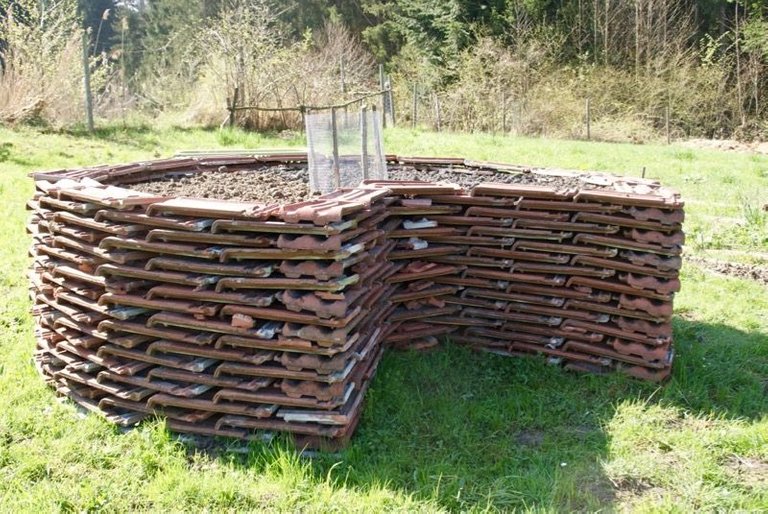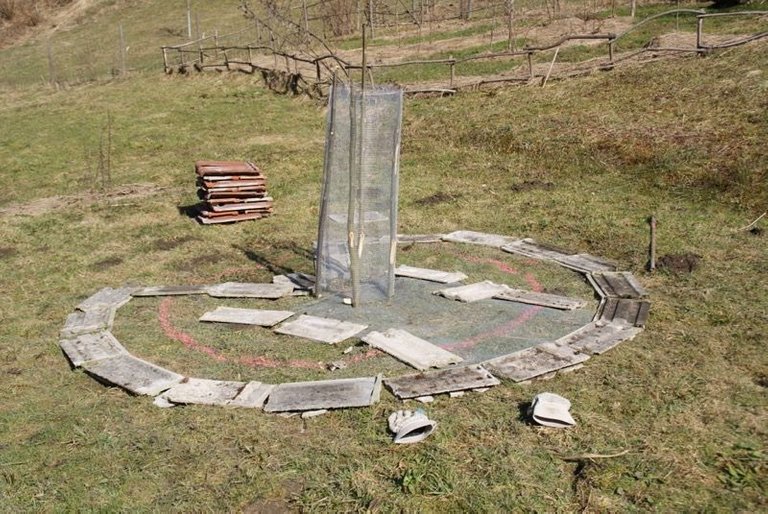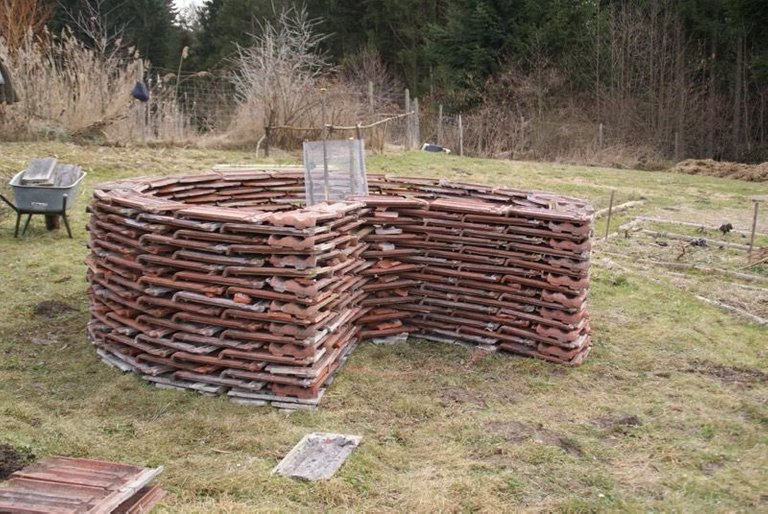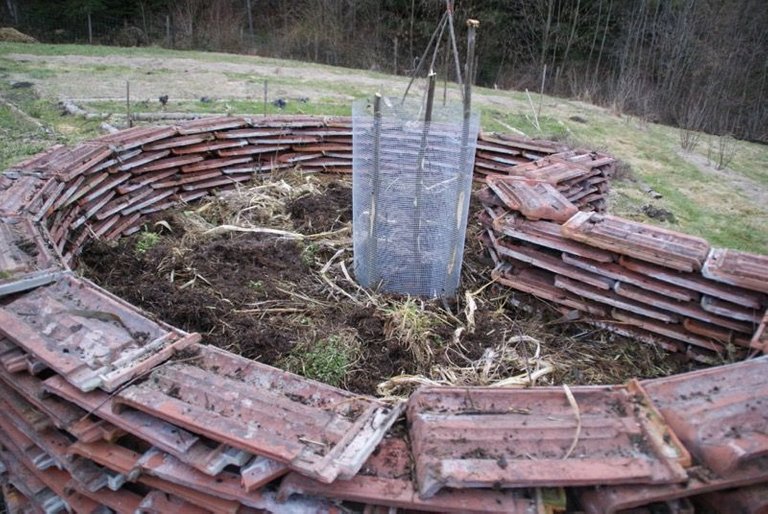| Deutsch | English |
|---|---|
| Heute möchte ich Euch zeigen, wie wir unser erstes Schlüsselloch-Hochbeet gebaut haben. Alle Materialien hatten wir vor Ort: Beton- und Tondachziegel bekamen wir geschenkt, als wir beim Abbau halfen. Stücke von Drahtgeflecht haben wir in unserem Schuppen gefunden. Füllmaterial ist in einem Permakulturgarten immer reichlich vorhanden. | Today I would like to show you how we built our first raised keyhole bed. We had all materials on site: We were given concrete and clay roof tiles when we helped with the dismantling. We found pieces of wire mesh in our shed. Filling material is always abundant in a permaculture garden. |
| Ein Schlüsselloch-Beet ist rund mit einem offenen Kompostbehälter in der Mitte. An einer Seite gibt es eine Einkerbung (Schlüsselloch) zum einfachen Befüllen des Kompostbehälters. Das Kompostmaterial wird laufend zugegeben, verrottet, und über die offenen Seiten des Kompostbehälters wandern Nährstoffe direkt in das Beet und sorgen für schonende Düngung. Kompostwürmer können sich ungehindert zwischen Kompost und Beet bewegen wodurch die Bodenstruktur verbessert wird. Als Hochbeet ausgeführt bewirkt die Verrottungswärme des Füllmaterials eine frühere Erwärmung der Erde und damit früheres Wachstum. Außerdem kann so auch auf ungeeignetem Untergrund Gemüse angebaut werden. Das Schlüsselloch-Hochbeet ist zudem sehr rückenschonend :) | A keyhole bed is round with an open compost container in the middle. On one side there is a notch (keyhole) for easy filling of the compost container. The compost material is continuously added, rots, and nutrients migrate directly into the bed via the open sides of the compost container and ensure gentle fertilization. Compostworms can freely move between compost and bed, improving the soil structure. Designed as raised beds, the rotting heat of the filling material causes an earlier heating of the soil and thus earlier growth. In addition, vegetables can also be grown on unsuitable ground. The raised keyhole bed is also very back-friendly :) |

| Grundfläche vorbereiten | Preparing the base |
|---|---|
| Zuerst haben wir einen Kreis mit dem gewünschten Durchmesser am Boden markiert. Er sollte so bemessen sein, dass man von der Seite aus alle Bereiche gut erreichen kann. Den Kompostbehälter ebenfalls mit einrechnen! Den Boden haben wir mit Drahtgeflecht ausgelegt, um zu verhindern, dass es sich Mäuse in unserem Beet gemütlich machen. Den Kompostbehälter haben wir ebenfalls aus Drahtgeflecht gebaut - er sollte so stabil sein, dass er später nicht vom Substrat eingedrückt werden kann. Danach legten wir die ersten Reihen Dachziegel (die aus Beton, um die Tondachziegel vor Feuchtigkeit zu schützen. | First we marked a circle with the desired diameter on the ground. Its dimensions should be such that all areas can be easily reached from the side. Also include the compost container! We have laid out the floor with wire mesh to prevent mice from making themselves comfortable in our bed. We also built the compost container from wire mesh - it should be so stable that it cannot be pushed in by the substrate later. Then we laid the first rows of roof tiles (the ones made of concrete to protect the clay roof tiles from moisture. |

| Aufbau | Construction |
|---|---|
| Der weitere Aufbau erfolgte mit den Tondachziegeln. Dafür sollte man sich wirklich Zeit nehmen und immer wieder die Stabilität kontrollieren. Wackelnde Ziegel werden mit Tonscherben oder kleinen Steinen verkeilt. Außerdem muss darauf geachtet werden, dass die Wände nicht nach außen kippen. Wenn die gewünschte Höhe erreicht ist, kann das fertige Beet befüllt werden. | Further construction was done with clay roof tiles. You should really take your time and check the stability again and again. Wobbling bricks are wedged with fragments of clay fragments or small stones. In addition, care must be taken to ensure that the walls do not tilt outwards. When the desired height is reached, the finished bed can be filled. |

| Befüllen des Beetes | Filling the bed |
|---|---|
| Zum Befüllen des Schlüsselloch-Hochbeetes haben wir den gleichen Aufbau wie bei einem Hochbeet oder einem Hügelbeet gewählt. Das heißt: begonnen wird mit grobem Material wie Ästen, danach kommt Strauch- und Staudenschnitt. Die nächste Schicht könnten Gemüseabfälle sein oder Rohkompost. Den Abschluss bildet eine gute Schicht Erde/Kompost. Dann kann gepflanzt oder gesät werden. Mulchen nicht vergessen - Hochbeete trocknen schneller aus als flache Beete! | For filling the keyhole raised bed we have chosen the same structure as for a raised bed or a hill bed. This means: we start with coarse material such as branches, followed by shrub and perennial pruning. The next layer could be vegetable waste or raw compost. The final layer is a good layer of soil/compost. Then it can be planted or sown. Don't forget to mulch - raised beds dry out faster than flat beds! |

| Bisherige Erfahrungen | Past experiences |
|---|---|
| Bisher sind unsere Erfahrungen sehr gut - das Schlüsselloch-Beet hat den Winter unbeschadet überstanden und erste Saaten sind bereits wieder gesät (Radieschen, Asiasalat, Feldsalat, Spinat, ...). Im Spätherbst haben wir nochmal Erde aufgefüllt, da sich das Beet durch die Verrottung ziemlich gesenkt hat. Beim nächsten Versuch würden wir auch an den Innenseiten Drahtgeflecht anbringen, da zwar keine Wühlmäuse von unten, dafür aber Feldmäuse von den Seiten eingewandert sind :) | So far our experiences are very good - the keyhole bed has survived the winter undamaged and the first seeds are already sown again (radishes, Asian salad, lamb's lettuce, spinach,...). In the late autumn we filled up the soil again, as the bed has sunk quite a bit due to the rotting. At the next attempt we would also attach wire mesh to the inner sides, since no voles from below, but field mice have immigrated from the sides :) |
If you like my posts, I appreciate your comments, upvotes and resteems.
www.hortus-permaculturis.at nachlesen!
You can read more about our permaculture garden on our website
www.hortus-permaculturis.at (only in German, sorry)!
Danke für diesen interessanten Beitrag! Auch eure Webseite bietet viele wertvolle Informationen :)
Vielen Dank für dein Interesse! Toll, dass du auch unsere Webseite besucht hast - wir hoffen, dass sich einige Menschen ein wenig anstecken lassen und wieder mehr Bezug zur Natur entwickeln :)
Very Clever so ein Hochbeet. Tolle Beiträge da kriegt man gleich Lust raus auf's Land zu ziehen und sich selbst mit einem tollen Garten zu versorgen.
Vielen Dank!
Ja, uns macht das echt viel Freude. Klar ist es auch Arbeit, aber wenns Spaß macht, sieht man es ja nicht als Arbeit :)
you make me want a garden!
For a start you could have one on a balcony or simply in a large pot.Haha @libaws!
my balcony is big enough for two people to stand . I do have flowers and herbs growing from my balconies :)
haha ok :)
Perfect - then you´re already a passionate urban gardener!
Gratuliere! Sehr schön!
Congratulations @sigrid.nepelius! You have completed some achievement on Steemit and have been rewarded with new badge(s) :
Click on any badge to view your own Board of Honor on SteemitBoard.
For more information about SteemitBoard, click here
If you no longer want to receive notifications, reply to this comment with the word
STOP